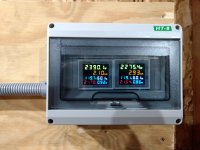mo1
Platinum Member
I might run the tractor for a generator too if our power outages were due to storms. But the last several have been due to forest fires and before that floods. So we need the big tractor free to be used. That's why we keep a hundred HP tractor fueled and ready to use.
On 510 vs 540 RPM question.... Voltage output goes down in proportional to the square of the decrease in RPM. That's reasonable for resistance heaters and not so good for computers, lights or TV.
The drop in frequency is less than the drop in voltage. Frequency is just a regular linear thing. i.e. drop the RPM in half and the frequency drops in half as well. But the problem is that it is the 60 cycle frequency is important to keep constant for some computer circuits. And nowadays even the coffee pot has a computer chip.
Best to just run it at the rated speed if you can.
rScotty
The things in your house that you run that particularly care about voltage and frequency being in a narrow tolerance range are induction motors, such as the motors in most air conditioners, blowers, refrigerators, and pumps. Too low of a voltage and they can't make rated power at rated amperage draw, so they draw more current and thus get hotter than they are supposed to. Too high of a voltage and there is flux saturation which also leads to excessive current draw and overheating. Operating speed is directly proportional to frequency, and if the frequency is too low, the motor runs too slowly, and if it's too high, the motor runs too fast. The major issues with this is a typical capacitor-start centrifugal-switch single-phase induction motor generally won't turn off its start circuit until 80-85% of rated speed, and keeping the start circuit energized for more than a few seconds can destroy it. Also, running certain motors too fast can lead to bearing failure, fan failure, or failure of whatever it is driving due to excessive speed. Resistance heaters and incandescent light bulbs can happily run on lower voltage, they simply make less heat/run at less brightness, and lights may flicker if the frequency gets way too out of spec. High voltage will cause premature failure though.
At least remotely modern computers (with an active power factor correction power supply) generally don't care too much about frequency or voltage as their power supplies rectify AC into DC, and this is not sensitive to input frequency, and the DC bus is voltage regulated with a wide regulation range. Look at the power supply on a computer and it will generally be marked for 100-240 volts, 50-60 Hz. Newer commercial lighting with an electronic driver or ballast (newer fluorescents, all LEDs, newer HID lights) have a driver or ballast that works very similarly to the computer power supply, so they are also insensitive to frequency and generally run on a wide voltage range as well (120-277 volts +/- 10%.)
Going back to why some PTO generators are rated for 510 input RPM rather than 540 has to deal with the gearbox used between the PTO input and the generator. Generators have to run at something just in excess of their synchronous speed which is (desired Hz * 60)/(number of pairs of poles in the generator). For a typical smaller two-pole generator, it must be driven at least 3600 RPM to make 60 Hz, and thus a gearbox is required to take a standard PTO speed of 540 or 1000 RPM and increase it to >3600 RPM. I suspect for the 510 RPM units, they took a 1:3.6 gearbox designed to run a two-pole generator on a 1000 RPM PTO and coupled it to a four-pole motor, which only has to be driven at half the speed of a two-pole motor, and thus you would need a touch over 500 RPM to run the motor. The slower-turning four-pole generators are quieter than the two-pole units and I suspect this is really why the 510 RPM units are out there.




